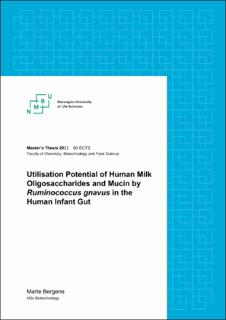| dc.contributor.advisor | Rudi, Knut | |
| dc.contributor.advisor | Nilsen, Morten | |
| dc.contributor.author | Bergene, Marte | |
| dc.date.accessioned | 2021-11-11T11:28:40Z | |
| dc.date.available | 2021-11-11T11:28:40Z | |
| dc.date.issued | 2021 | |
| dc.identifier.uri | https://hdl.handle.net/11250/2829093 | |
| dc.description.abstract | The human gut microbiota plays an important role in the health and immune development of the body. Gut bacteria can utilise carbohydrates that are unavailable to human enzymes, like human milk oligosaccharides (HMOs) present in breast milk, and produce short chain fatty acids (SCFAs) as fermentation products. HMOs are thought to be a selective force for colonisation of the gut the first months of life. The gut microbe Ruminococcus gnavus is found present in both infants and adults, and has previously been associated with disorders like Crohn’s and eczema, and general dysbiosis. R. gnavus is a known utiliser of mucin glycans produced by the epithelium of the intestine, which resembles HMOs in structure. The idea that R. gnavus might utilise HMOs instead of or in addition to mucin stirs the thought that colonisation of R. gnavus might affect the colonisation of Bifidobacterium and other favourable bacteria. The aim of this thesis was to investigate the mucin and HMO degrading potential of R. gnavus and the potential for propionic acid production by R. gnavus in the infant gut.
Faecal samples from 6-month-old infants, collected through the study Prevent Atopic Dermatitis and Allergies (PreventADALL), were analysed. Microbial composition was determined through 16S rRNA gene sequencing, short chain fatty acid composition was determined using gas chromatography, genes in the R. gnavus genome were identified through shotgun sequencing, proteins were identified using mass spectrometry, and expression of genes coding glycan degrading proteins was determined using quantitative PCR (qPCR).
The results showed a complete pathway for propionic acid production in the genome and proteome, indicating propionic acid production by R. gnavus in the infant gut, as previously shown in the adult gut. Fucosidases, β-galactosidases, sialidases and several mucin specific enzymes were identified in the proteome of all or some of the samples, while no HMO specific enzymes were found in any proteome. Complete pathways for degradation of glucose, galactose and N-acetylglucosamine (GlcNAc) were identified. The results indicate that mucin degradation is more important than HMO in R. gnavus, but that HMOs might be partially degraded. It is difficult to predict the preferred substrate, as many of the identified enzymes can be used on both mucin and HMOs. High abundance of R. gnavus is thought to be unfavourable, because of the properties of R. gnavus and the negative correlation with Bifidobacterium. Lack of Bifidobacterium is a sign of a more adult gut which is unwanted during infancy. The results from this thesis lay the foundation for further studies on glycan degradation by R. gnavus, like gene expression analysis and growth experiments on different mucins and HMOs. | en_US |
| dc.description.abstract | Tarmmikrobiotaen i menneske spelar ei viktig rolle for kroppen si helse og immunutvikling. Tarmbakteriar kan nytta karbohydrat som ikkje er tilgjengelege for humane enzym, som oligosakkarid funne i morsmjølk (HMO), og produserer kortkjeda feittsyrer som fermenteringsprodukt. Ein trur HMOer har ei selektiv kraft ved kolonisering av tarmen dei fyrste levemånadene. Tarmmikroben Ruminococcus gnavus finnes i både spedborn og vaksne, og bakterien er tidlegare blitt assosiert med lidingar som Krohns, eksem og generelt ved dysbiose i tarmen. R. gnavus er kjend for å nytta mucin glykan produsert av tarmepitelet, som liknar HMO i struktur. Ideen om at R. gnavus kanskje nyttar HMO i staden for eller i tillegg til mucin har vekkja tankar om at R. gnavus kanskje påverkar koloniseringa av Bifidobacterium og andre gunstige bakteriar. Målet med oppgåva var å undersøkje potensialet R. gnavus har til å nytte mucin og HMO, og potensialet for produksjon av propionsyre i tarmen til spedborn.
Avføringsprøvar frå seks månader gamle spedborn, samla inn gjennom studien Prevent Atopic Dermatitis and Allergies (PreventADALL), vart analysert. Mikrobiell samansetjing vart bestemt gjennom 16S rRNA gensekvensering, samansetjing av kortkjeda feittsyrer vart bestemt ved bruk av gasskromatografi, det genetiske potensialet til R. gnavus vart identifisert ved shotgun sekvensering, protein vart identifisert ved massespektrometri og uttrykket av glykan-nedbrytande gen vart bestemt ved bruk av kvantitativ PCR (qPCR).
Resultata viste ein komplett produksjonsveg for propionsyre i genomet og proteomet, som indikerer produksjon av propionsyre frå R. gnavus i tarmen til spedborn, som tidlegare vist hjå vaksne. Fukosidaser, β-galaktosidaser, sialidaser og fleire mucin-spesifikke enzym vart identifisert i proteomet til alle eller nokre prøvar, men ingen HMO-spesifikke enzym vart funne. Komplette nedbrytingsvegar for glukose, galaktose og N-acetylglukosamine (GlcNAc) vart identifisert. Resultata indikerer at nedbryting av mucin er viktigare i R. gnavus, men at HMO kanskje blir delvis nedbrote. Det er vanskeleg å sjå kva substrat R. gnavus vil føretrekka, då R. gnavus kan nytte mange av enzyma på både mucin og HMO. Ein trur mykje R. gnavus i tarmen til spedborn ikkje er gunstig, på bakgrunn av eigenskapane til bakterien og den negative korrelasjonen til Bifidobacterium som er funne. Mangel på Bifidobacteirum er eit teikn på ein meir vaksen tarmmikrobiota, noko som ikkje er ynskja tidleg i livet. Resultata frå oppgåva legg grunnlaget for vidare studiar på glykan-nedbryting i R. gnavus, i form av genuttrykksanalyser og dyrkingseksperiment på ulike mucin og HMOer. | en_US |
| dc.language.iso | eng | en_US |
| dc.publisher | Norwegian University of Life Sciences, Ås | en_US |
| dc.rights | Attribution-NonCommercial-NoDerivatives 4.0 Internasjonal | * |
| dc.rights.uri | http://creativecommons.org/licenses/by-nc-nd/4.0/deed.no | * |
| dc.title | Utilisation potential of human milk oligosaccharides and mucin by Ruminococcus gnavus in the human infant gut | en_US |
| dc.type | Master thesis | en_US |
| dc.description.localcode | M-BIOTEK | en_US |

